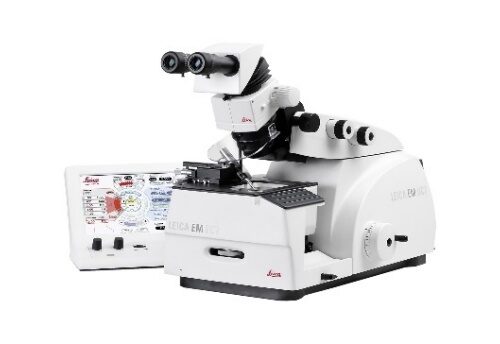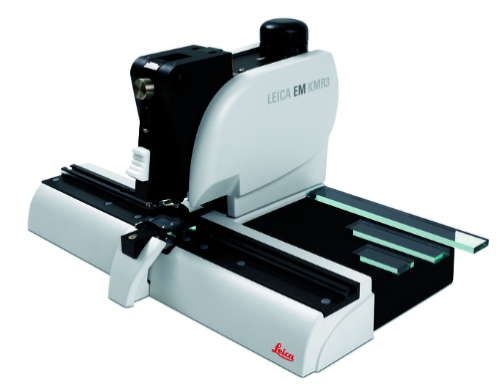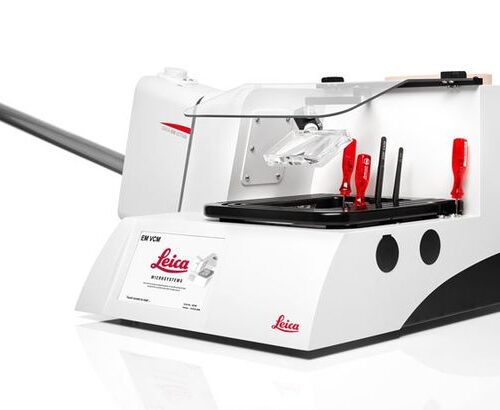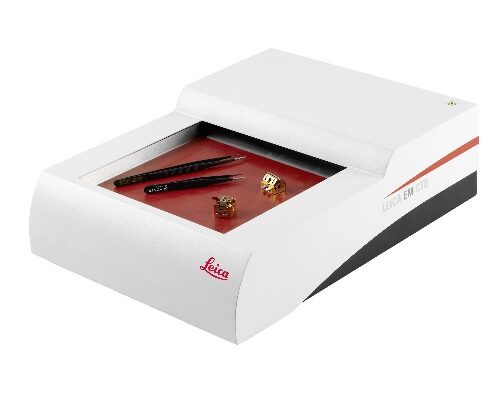-
 The Leica EM UC7 prepares excellent quality semi- and ultra-thin sections, as well as the perfectly smooth surfaces required for LM, TEM, SEM, and AFM examination. The precision mechanics, ergonomic design, and intuitive layout of the touchscreen control unit make the Leica EM UC7 ideal for the highest quality specimen preparation
The Leica EM UC7 prepares excellent quality semi- and ultra-thin sections, as well as the perfectly smooth surfaces required for LM, TEM, SEM, and AFM examination. The precision mechanics, ergonomic design, and intuitive layout of the touchscreen control unit make the Leica EM UC7 ideal for the highest quality specimen preparation -
 Low temperature ultrathin cryosectioning of biological and industrial samples. Can be mounted on the EM UC7 and the ARTOS 3D. The EM FC7 outfitted with an EM VCT500 transfer port is the ideal solution for environmentally sensitive sample and / or cryogenic sample
Low temperature ultrathin cryosectioning of biological and industrial samples. Can be mounted on the EM UC7 and the ARTOS 3D. The EM FC7 outfitted with an EM VCT500 transfer port is the ideal solution for environmentally sensitive sample and / or cryogenic sample -
 The ARTOS 3D (ARray TOmography Solution) automatically creates and collects hundreds of serial-sections ribbons all ready for array tomography with your scanning electron microscope (SEM).
The ARTOS 3D (ARray TOmography Solution) automatically creates and collects hundreds of serial-sections ribbons all ready for array tomography with your scanning electron microscope (SEM). -
 The balanced break method of the Leica EM KMR3 ensures perfect glass knives in three thicknesses 6,4 mm, 8 mm, and 10 mm.
The balanced break method of the Leica EM KMR3 ensures perfect glass knives in three thicknesses 6,4 mm, 8 mm, and 10 mm. -
 With Leica EM VCT500 you can transfer samples under cryogenic conditions or at room temperature as well as under vacuum or protected atmosphere.
With Leica EM VCT500 you can transfer samples under cryogenic conditions or at room temperature as well as under vacuum or protected atmosphere. -
 The Leica EM VCM loading station enables you to connect different preparation techniques to various analysis devices such as Cryo-SEM, Cryo-TEM and Cryo-CLEM
The Leica EM VCM loading station enables you to connect different preparation techniques to various analysis devices such as Cryo-SEM, Cryo-TEM and Cryo-CLEM -
 The THUNDER Imager EM Cryo CLEM is a cryo light microscope featuring opto-digital THUNDER technology. It provides the imaging data and secure cryo conditions you need for successful experimental investigations concerning structural biology.
The THUNDER Imager EM Cryo CLEM is a cryo light microscope featuring opto-digital THUNDER technology. It provides the imaging data and secure cryo conditions you need for successful experimental investigations concerning structural biology. -
 High pressure freezing is key for the study of intricate changes in fine structure or cellular dynamics. Cryo-immobilize your aqueous samples under high pressure with a unique freezing principle and uncover secrets of the cellular process.
High pressure freezing is key for the study of intricate changes in fine structure or cellular dynamics. Cryo-immobilize your aqueous samples under high pressure with a unique freezing principle and uncover secrets of the cellular process. -
 The EM GP2 plunge freezes fluid or extremely thin samples spread on an electron microscopy grid into liquid ethane after removing excess fluid by automatic blotting.
The EM GP2 plunge freezes fluid or extremely thin samples spread on an electron microscopy grid into liquid ethane after removing excess fluid by automatic blotting. -
 Freeze Substitution and Low Temperature Embedding System The Leica EM AFS2 performs freeze substitution and progressive lowering of temperature (PLT) techniques and allows low temperature embedding and polymerization of resins.
Freeze Substitution and Low Temperature Embedding System The Leica EM AFS2 performs freeze substitution and progressive lowering of temperature (PLT) techniques and allows low temperature embedding and polymerization of resins. -
 During Cryo preparation, tools such as forceps and sample holders often ice over and cannot be immediately used for the next sample run. De-icing and drying of the tools at room temperature is time consuming and can cause damage to sensitive components and may prevent their operation.
During Cryo preparation, tools such as forceps and sample holders often ice over and cannot be immediately used for the next sample run. De-icing and drying of the tools at room temperature is time consuming and can cause damage to sensitive components and may prevent their operation. -
 Producing homogenous and conductive metal or carbon coatings for SEM and TEM analysis was never more convenient than with the Leica EM ACE200 coating system.
Producing homogenous and conductive metal or carbon coatings for SEM and TEM analysis was never more convenient than with the Leica EM ACE200 coating system.
